Menus
- Four velvet legs
- Discovery
- Start-up
- In the city
- On the road
- On the highway
- In duet
- Braking
- Consumption
- Maintenance
- Production
- Chronology
- On the side ….
- In case of purchase
- Identification
- Conclusion
Four velvet legs
At the 1968 Tokyo Motor Show, the manufacturer Honda revolutionized the world of motorcycles by presenting its new machine, the CB 750. Available in France from June of the following year, it immediately established itself as the absolute queen, instantly going out of fashion. all other big engines. This modern motorcycle will shake up the biker planet by bringing together the best of technology, bringing together performance, reliability and simplicity. It also opened the era of the four-stroke multicylinder motorcycle ….
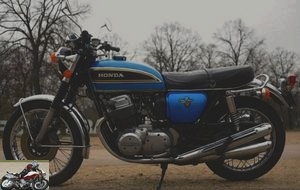
Discovery
On board the K6, we immediately notice the width of the engine overflowing on each side of the tank, itself already very imposing. The eyes are drawn to the dashboard and its two magnificent dials on a dark green background. Opulent atmosphere, the CB 750 imposes it !
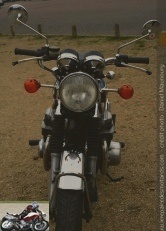
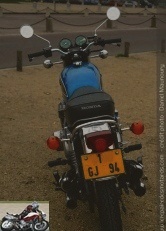
Start-up
Contact, (under the can, left side), a little push on the right stalk is enough to animate the machinery. Forget the kick, this is modernity! A few strokes of gas to see that the tachometer needle goes down as quickly as it goes up, a sign of low engine inertia ….
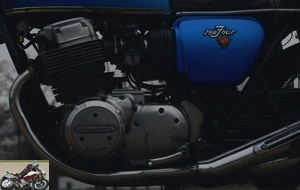
In the city
The gearshifts are firm and grip slightly if you don’t take the time to break down the movements well, like many of these vintage bikes. The space requirement makes it quite easy to navigate an urban landscape. Sure, this is a big machine, but its intrusions into the city do not amount to torture ….
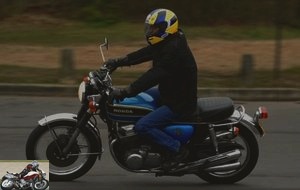
On the road
The mill, flexible and powerful, available throughout its range of use, becomes truly symphonic from 5,000 rpm, thanks to its four magnificent exhausts. The tubular chassis is as smooth as the engine, resulting in rather haphazard handling and the brakes are not very efficient, but in the old days an original disc was a revolution and the option of a second was a definite plus..
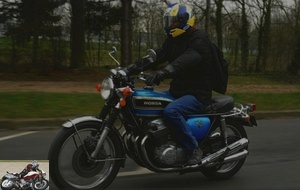
On the highway
Its generous engine makes it possible to achieve a pace which is totally prohibited today. Not to mention the Saint-Guy dance, the motorcycle waves at high speed, past 150 km / h. In case of surprise, the braking is not overkill. In addition, the lack of protection makes the exercise difficult. Obviously, the CB 750 clearly prefers the road to toll ribbons. !
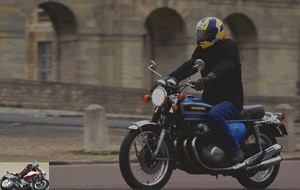
In duet
The Four is a living motorbike, endowed with a soul, often an accomplice and as charismatic as it is beautiful. Enjoying it together is even better, especially as the saddle is shared in comfort. However, the affixing of a support bar, as on the model tested here, seems essential to maintain friendly ties with the passenger ….
Braking
With the original front disc, there is no risk of breaking teeth on the dashboard. At the rear, a feeble drum keeps it out of the way. It was not uncommon at the time to add an extra disc to alleviate these annoyances. Anticipation is therefore essential ….
Consumption
Gas constantly, we can curl the 8l / 100. Never more. While driving peacefully, the Four has a moderate appetite, around 6.5 l ….
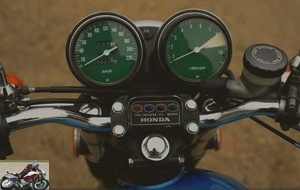
Maintenance
The quat’pots deserves its reputation for reliability. Regular maintenance is sufficient and does not require special equipment or skills. An engine oil change every 5,000 km with semi-synthetic oil is to be expected with the replacement of the oil filter. At the same time, clean the oil pump strainer located in the lower crankcase to prevent clogging of the oil passages at the camshaft. Regular lubrication of the swingarm axle will prevent the latter from seizing. The heating time must be scrupulously respected to preserve its mechanical components. Thanks to the simplicity of the mechanics and the robustness of this machine, an oven run respectfully and with love remains indestructible..
Production
Since its release in 1969, the Honda CB 750 has been called the “motorcycle of the century” for its technological breakthrough, but also for its commercial success. Produced at 553,000 units worldwide, Honda did not expect such a craze. All categories combined, the 750 Four was sold in France in more than 22,000 copies.
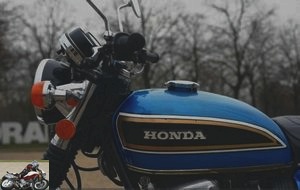
Chronology
Honda CB 750 prototype : Honda unveils this prototype for the first time in 1968 which might not have been as successful if it had been marketed with its front drum brake.
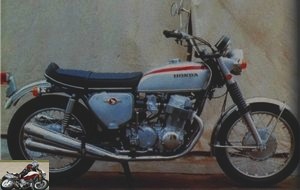
Honda CB 750 : Launch of the 4 legs on June 6, 1969. We got into the habit of calling the first Four "K Zero", a name not approved by the manufacturer at the time. It was marketed until 1970 and sold in France in 1793 copies in the colors old gold, red and metallic blue-green..
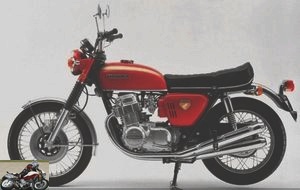
Honda CB 750 K1 : Marketed in 1970 and 1971, 3,259 copies sold, the K1 differs from the "K0" by the more rounded side covers and mentioned "750 Four", the air filter box, the shape of the saddle and the control of the carburettors by lifting beam. It was available in 4 colors: gold, red, green and metallic brown.
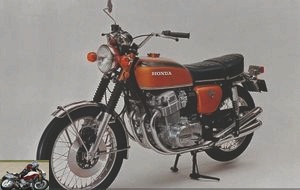
Honda CB 750 K2 : The K2 is the most widely distributed CB 750 having been sold from 1972 to 1975 to 8,499 copies. It is distinguished by its chrome headlight brackets and black cup, a more elaborate dashboard, the key locking of the saddle, a new type of shock absorbers and new exhaust baffles. Available in red, blue and metallic brown.

Honda CB 750 K6 : Appeared in 1974 and sold until 1976 to 3,395 copies, the K6 still evolves with a self-lubricated reinforced secondary chain, a lifting handle transformed into a hoop around the saddle, a deflector on the brake disc, a valve of gasoline located on the left side of the tank and a redesigned "750 Four" monogram. Available in red and metallic blue.
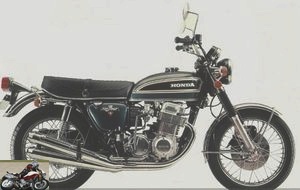
Honda CB 750 K7 : Arrived in France in June 1977, the K series reappeared with this K7 model. 1,516 units were sold with the following modifications: four new exhausts, a 19 L tank, a two-stage saddle, a 17-inch rear wheel, a starter on the dashboard and GL 1000 indicators. Choice of two colors, black and metallic brown.
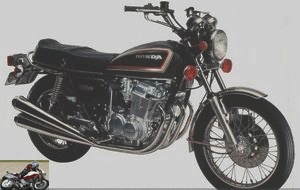
Honda CB 750 F1 : Marketed from 1975 to 1977, the F1 was sold 2305 copies. The "F" series is marked by many changes both aesthetically and technically such as the compression ratio increased to 9.2 to 1 thanks to new domed pistons, a new camshaft, shortened gear ratios , a new fork and a caster angle of 62 ° instead of 63 °, without forgetting the 4 in 1 exhaust. Side cycle part, we will note a disc brake at the rear with two-piston caliper and a new front caliper , an elongated tank, a backrest saddle forming a trunk and the name "super sport". Two colors available, yellow and metallic red.
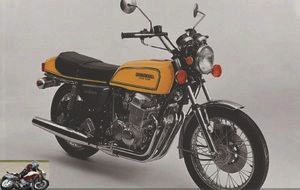
Honda CB 750 F2 : Appeared at the 1977 Paris Motor Show, the F2 was sold 1671 copies until the end of marketing of the famous "Four". Among the latest modifications are a new 4-in-1, Comstar spoked wheels, dual front brake discs, light alloy plate-mounted footrests, a matte black painted engine and a new mudguard. AR. This F2 was available in black / blue and black / burgundy.
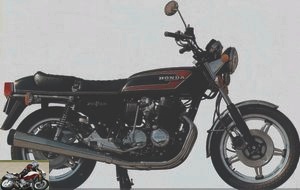
Other versions were also marketed but not imported in France, such as the K3, K4, K5, K8 and F3, mainly intended for the United States..
On the side ….
Models completely reconditioned according to the rules of the art can reach 8 / 9,000 €. For the very first K0 models in pristine condition, prices can soar as high as € 15,000.
In case of purchase
Considering the success of this bike, one could think of a wide choice in the classifieds. Unfortunately it is not and finding happiness can look like an obstacle course, unless you have a significant budget. You can find an Oven from 3,000 €, but in poor condition and often hacked everywhere. For an original machine, depending on its general condition, count between 5,000 and 7,000 €.
When purchasing, be careful of the general condition of course, but also that of the exhausts, as their price (around € 1,000) may be taken into account in the price. Also beware of "true-false" by observing the identification table.
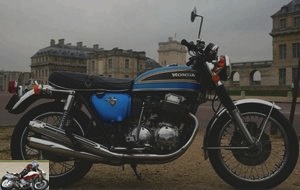
Identification
- CB 750 (KO) 1969-1970 frame from N ° 1000001 engine from N ° E10000001
- K1 1970-1971 frame from N ° 1044650 engine from N ° 1044806
- K2 1972-1975 frame from N ° 2006212 engine from N ° 20000001
- K6 1974-1976 frame from N ° 2540001 engine from N ° E2428762
- K7 1977-1979 frame from N ° 2707450 engine from N ° E2707484
- F1 1975-1977 frame from N ° E1000007 engine from N ° FE2500009
- F2 1977-1979 frame from N ° 2100016 engine from N ° 2600016
Conclusion
Reliable, efficient, stylish, versatile, the CB 750 will mark its time and several generations of bikers conquered in advance. What amply deserves its name of "motorcycle of the century". The CB 750 bowed out in 1979, a decade of Four’s history. In the meantime, she will have been given all the nicknames…. "Four legs, four pots, four pipes, four tubes …. ", Expressions of affection for him (and still carries him!), His admirers. The CB 750 is eternal and always arouses as much emotion as it passes. Forever anchored in the collective memory, without it, the adventure of the motorcycle would have been very different ….
Strong points
- Aesthetic
- Robust mechanics, reliability
- Ease of use and maintenance
- Performances
- Operation music
Weak points
- Braking limit
- Road holding due to the too flexible chassis
- Limited ground clearance
- Rarity in good condition, cost to purchase
The technical sheet of the Honda CB 750
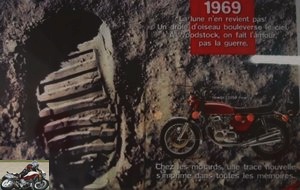
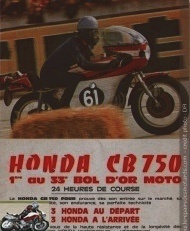
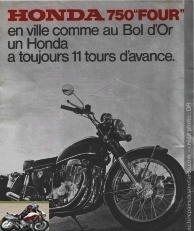
Related articles
-
900 new blood ! Praised since its presentation in 1972, the 900 Z1 Kawasaki has now become a legend …. A little history Imagined by Sam Tanegashima, an…
-
Madam DR ax ! At the beginning of the 80s, trail running was in vogue, sales exploded and manufacturers waged a merciless war by offering increasingly…
-
Honda NC 700 S motorcycle test
Crisis solution Honda revives the basic motorcycle with its NC 700 S: a floor price, practical aspects borrowed from the scooter and consumption at the…
-
Honda renews its big roadster. Retro, sporty, or both ? 4 cylinders in line, 998 cm3, 145 hp at 10,500 rpm, 104 Nm at 8,250 rpm, 212 kilos with full…
-
Waiting for the new Hornet… No, the CB 650 F is not the replacement for the Hornet. Healthy, easy and fast enough, it is intended primarily for…
-
Baby GS: the Trail is back Paradox. It is by imposing its flat on the Paris Dakar, that BMW has shifted the market from mono to twin, causing the…
-
497 cc, 82 hp, 190 km / h, the first mass-produced turbo motorcycle A Power Ranger look for an expensive but efficient grand tourer The turbo , it’s a…
-
Cool There is freedom in the new Triumph Street Scrambler. A freedom that comes from afar to take you very far. A freedom that has its roots in the…
-
Wes Cooley Replica or GS 1000 shake It was nicknamed Wes Cooley Replica , from the name of the American rider who, at the helm of a machine of similar…
-
Vyrus 986 M2 Strada motorcycle test
Modern and improved Pura follya tecnologica and Tesi 4 cylinders of Honda CBR60RR, 599 cm3, 118 hp and 66 Nm, 151 kg dry, € 37,930 excl. Sticking the…